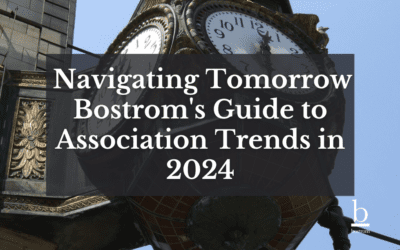This article first appeared in PIMA‘s Fall 2021 magazine.
Pre-pandemic, the association world was already feeling the impact of a changing market dynamic with technology advancements, millennials and Gen Z changing the membership landscape, and digital strategy’s effects on delivering value. What we saw the last 18 months was a hyper-focus on business models, digital strategy and the member experience caused by the disruption brought on by COVID.
As an association management company running 30 organizations and a consulting firm for large associations, Bostrom had a unique perspective into the transformation occurring and the change to the speed at which our agility had to perform. We’ve identified the six post-pandemic trends that associations will need to address now, and in the years to come.
Business Model Transformation: Customer Focus
In an ever-transforming environment, associations have had to take a hard look at their business models and organizational structures needed to support new definitions of value to their customers (meaning members, potential members, and stakeholders). We’ve used Alexander Osterwalder’s Business Model Canvas as a valuable template for working through the process—from business model innovation to implementation.
Associations are redefining their “value” and how they are going to market and deliver it to their customers in the post-pandemic world. This entails understanding their customers’ pain points, how they can uniquely solve problems for individuals, companies, and an industry or profession, and build products and services with a newly envisioned customer journey.
These new models have escalated the use of new technology platforms, integrated marketing strategies, and organizational structures that leverage partners, and outsourcing in innovative ways. All of this is happening while action-oriented DEI strategies and social impact initiatives are transforming the cultures within associations. Some of this disruption is long overdue; a lot of this “transformation driving” is what associations were built to do since their humble beginnings.
Value and Membership: A Symbiotic Partnership
For associations, the definition of value has always been aligned with the mission they were created to advance. Industry leaders, students, professionals, and academia have all come together for a common purpose: to have an impact on society through their missions. It is this underlying passion for a particular cause that brings members to the table to work together. Benefits of this type of collaboration have included career advancement; social impact in areas of patient care; industry advancements and sustainability and the incredible benefit of belonging to a community where you can build invaluable, lifelong relationships.
Where associations veer off-course is in focus. A laser focus on their mission and the aligned unique value they can deliver to its customers has to be at the core of the business model. The challenge is that associations are filled with passionate volunteers who sometimes bring bias and agendas that can derail value delivery, along with the business model itself. They hold on to old programs and services no longer providing value for too long, are risk averse to trying new things, and their rotating governance model just adds to inconsistency. Using data to help drive tough conversations has been an effective approach.
Missions don’t often change but value definitions and the products and services that deliver on that value proposition have transformed immensely and must continue to evolve to meet customers’ changing needs. Value is at the heart of membership growth and retention and always has been. Understanding stakeholder pain points, opportunities, wants and needs, and jobs they need to get done, is at the heart of developing a strong business model and product offerings to attract and retain members.
Associations’ Use of Influencers
When we talk about a value and customer-experience-centered business model, associations have a strong, long-held advantage in creating, delivering, and marketing value. Hidden within association members, and the connections of those members lie incredible access to influencers. Pioneers of professions and industries are at the heart of how and why associations were created. The founders and leaders within associations are usually celebrated, admired, even worshiped by members young and old.
With mobile-first and enhanced social media strategies, the opportunity for associations to connect with these influencers to grow membership, meeting programming and attendance, and content/education creation is endless. Influencer strategies like these are inexpensive, usually free, and will be a much larger part of association integrated marketing strategies in the future.
Affinity Programs
Non-dues revenue generation has been a key focus of association business models for many years. This comes in the form of education, credentialing, thought leadership/content products such as white papers and research, educational meetings and events, and affinity products. During my tenure as COO of the American Medical Association (AMA), our goal was to add value for AMA members by repositioning the association with a fiscally sound, market-based strategic plan. We reduced the AMA’s reliance on member dues providing bottom-line results by substantially increasing non dues revenue. How? All AMA assets were inventoried and monetized. New products and services that members wanted were created. The desired and actual result was that member dues was reduced from a majority to one-third of our total revenues, with non-dues growing to two-thirds of AMA’s revenue base And affinity products were a key part of our non-dues revenue budgets. Our affinity strategy was based on member research, focus groups, and being on the lookout for new players and products in the affinity space who could deliver what our customers were seeking or needing. The objective was always to align the affinity programs with members’ needs and the AMA’s mission.
Associations are inundated with product choices now, so the focus is on new requirements:
- Alignment with what members view as value or pain point resolution for them
- True price advantages
- The brand and reputation of the provider especially in terms of social impact and Corporate Social Responsibility
- True ROI for the association, comparing the revenue potential to the association staff and dollars time investment of the program
- The affinity partner is a true partner in marketing efforts
- The affinity partner understands and delivers on clear lines of data privacy and protection
- Ability to pilot a program before a full contract and launch
- Alignment with association mission and value proposition
Associations collect massive amounts of data, and using that data to identify successful affinity programs is an integral part of generating a new business model. Data such as age, geographic location, self-employed (gig) workers, DEI demographics, interests, social channels, education, credentials, etc. will help to identify what products will be inclusive and resonate.
If members have a ”sticky” (as opposed to transactional) relationship and are loyal to the association, then an affinity program stands a much better chance of competing with mass-market availability. Building that unique differentiation and communicating the benefit to their association’s customers with passion and purpose will drive new avenues of products and services, and ultimately non-dues revenue.
Gen Z & Membership
A recent book entitled ZCONOMY: How Gen Z Will Change the Future of Business – and What to Do About It by Jason Dorsey and Denise Villa, PhD, is a must-read for any business professional and association leader. Associations, if they can up their mobile, social, and digital game, are well-positioned to appeal to what next year will be the fastest-growing generation in the workforce.
What is the good news for associations? Gen Z workers and consumers of products want to connect with organizations that have social impact, that have purpose. Since associations are purpose-driven, mission-driven entities, they need to elevate and market their value to reach the hearts and minds of Gen Z, thereby creating greater stickiness with their customers. If value, purpose, and mission are communicated effectively and the customer experience meets or exceeds their expectations, Gen Z will join associations.
Gen Z & Digital Strategy
In recent consulting engagements, we’ve been overlapping the digital touchpoints associations have with their customers with the customer journey map to outline and align digital strategy to customer experience. Gen Z is already influencing how business is done and how it will be done in a massive way. They know nothing else except one-click purchases, videos to educate them on anything they want to know, voice-activated TVs and search, and they are connected 8+ hours per day online using multiple devices.
Associations must completely rethink their technology stacks to support these behaviors and expectations and incorporate a solid digital strategy with a positive customer user experience into their new business model. In terms of value delivery, loyalty programs and personalized experiences will become the norm along with mobile-first UX, one-click joining and registering, voice activation offered, and accessibility required.
Bostrom’s role as an association management company is to identify these trends and incorporate new strategies and models into our own company and our services to our association clients. Associations can take advantage of their unique positions to advance their missions and cause-related activities by addressing these six trends in creative, innovative, and tailored ways.





